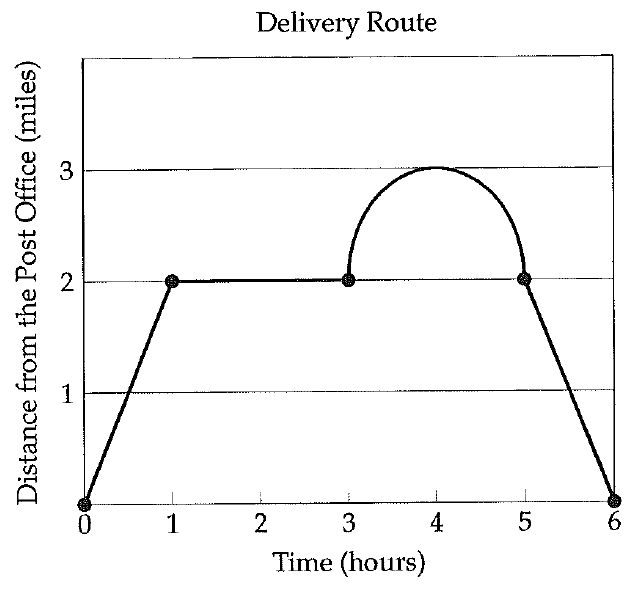SKETCHING RATIONAL FUNCTIONS
When we are sketching the graph of functions either by hand or through any graphing software we cannot show the entire graph. Only a part of the graph can be sketched.
A crucial question is which part of the curve we need to show and how to decide that part. To decide on this we use the derivatives of functions. We enlist few guidelines for determining a good viewing rectangle for the graph of a function. They are :
(i) The domain and the range of the function.
(ii) The intercepts of the cure (if any).
(iii) Critical points of the function.
(iv) Local extrema of the function.
(v) Intervals of concavity.
(vi) Points of inflections (if any).
(vii) Asymptotes of the curve (if exists)
Sketch the graphs of the following functions.
Problem 1 :
y = (x2+1)/(x2-4)
Solution :
Domain and range :
Possible values of x are R - {-2, 2} ==> Domain
y values are R - {0} ==> Range
Intercepts :
To find x intercept, put y = 0
(x2+1)/(x2-4) = 0
Since there is no real values of x, it will not intersect on x-axis.
y-intercept :
Put x = 0
y = -1/4
Critical points :
f(x) = (x2+1)/(x2-4)
u = x2 + 1 and v = x2-4
u' = 2x and v' = 2x
f'(x) = [2x(x2-4) - 2x(x2+1)] / (x2-4)2
f'(x) = [2x3-8x - 2x3-2x] / (x2-4)2
f'(x) = -10x / (x2-4)2
f'(x) = 0
-10x = 0
x = 0
Plotting these points on the number line and dividing into intervals, we get (-∞, 0) and (0, ∞).
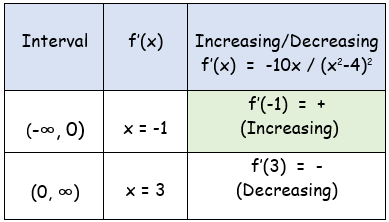
Local extrema :
f'(x) = -10x / (x2-4)2
u = -10x and v = (x2-4)2
u' = -10 and v' = 4x(x2-4)
f''(x) = [-10(x2-4)2+40x2(x2-4)] /(x2-4)4
f''(x) = -10(x2-4)[(x2-4)+4x2] /(x2-4)4
f''(x) = -10(x2-4)(5x2-4) /(x2-4)4
f''(0) = - < 0 (Maximum)
Maximum point :
When x = 0
y = (x2+1)/(x2-4)
y = -1/4
So, the maximum point is (0, -0.25)
Intervals of concavity :
f''(x) = -10(x2-4)(5x2-4) /(x2-4)4
f''(x) = 0
(x2-4)(5x2-4) = 0
|
x2-4 = 0 x = 2, -2 |
5x2-4 = 0 x = 2/√5 and x = -2/√5 |
Point of inflection :
f(x) = (x2+1)/(x2-4)
When x = 2 and -2, y approaches ∞. Let us find asymptotes to get the graph more clearly.
Asymptotes :
Horizontal asymptote :
Degree of numerator = degree of denominator
y = leading coefficient of numerator/leading coefficient of denominator
y = 1/1 ==> 1
Vertical asymptote :
x2-4 = 0
x = 2, -2
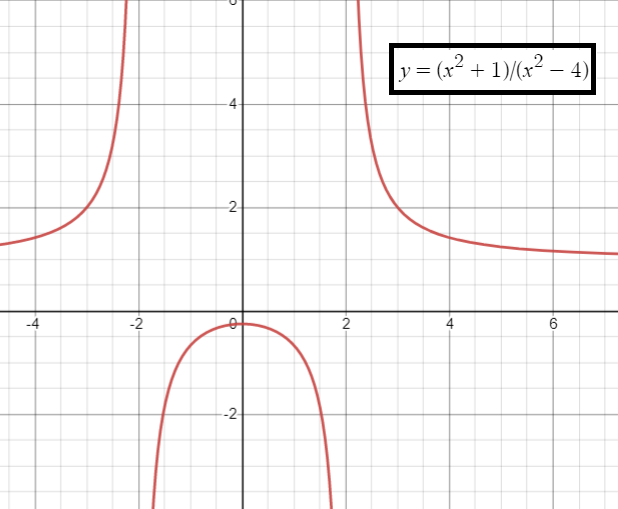
Problem 2 :
y = 1/(1+e-x)
Solution :
The function is defined for all real values of x.
So, domain is all real values and range is (0, 1).
Intercepts :
When x = 0, y = 1/2
So, y-intercept is (0, 1/2).
Critical points :
f'(x) = [(1+e-x) (0) - 1(-e-x)]/(1+e-x)2
f'(x) = 1(e-x)/(1+e-x)2
f'(x) = 0
e-x/(1+e-x)2 = 0
e-x = 0
Which is not possible, so there is no maximum.
Asymptotes :
No vertical asymptote. From the domain, we know vertical asymptotes are y = 0 and y = 1.
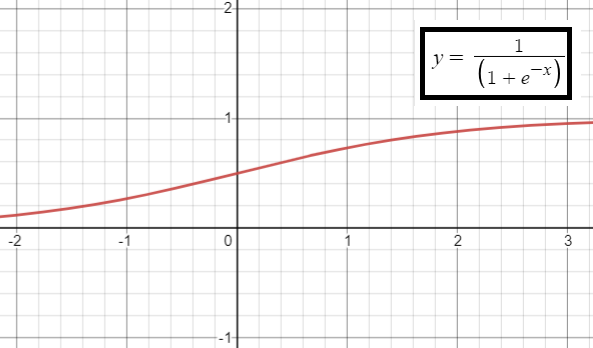
Problem 3 :
y = x3/24 - log x
Solution :
y = x3/24 - log x
Domain :
y is defined only for positive values.
Intercepts :
There is no intercepts.
Critical points :
f'(x) = 3x2/24 - 1/x
f'(x) = x2/8 - 1/x
f'(x) = 0
x2/8 - 1/x = 0
x2/8 = 1/x
x = 2
Local extrema :
f''(x) = 2x/8 + 1/x2
f''(x) = x/4 + 1/x2
f''(2) = 2/4 + 1/22
= 1/2 + 1/4
= 3/4 > 0 (minimum)
Minimum point :
f(2) = 23/24 - log 2
f(2) = 1/3 - log 2
From here, range is 1/3 - log 2 > ∞.
Point of inflection :
There is no point of inflection.
There is no horizontal asymptotes. Vertical asymptote is y = 0.
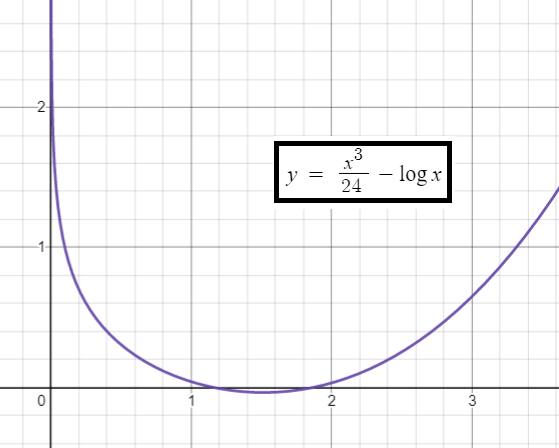

Apart from the stuff given above, if you need any other stuff in math, please use our google custom search here.
Kindly mail your feedback to v4formath@gmail.com
We always appreciate your feedback.
©All rights reserved. onlinemath4all.com
Recent Articles
-
AP Calculus AB Problems with Solutions (Part - 8)
Jan 30, 25 09:48 AM
AP Calculus AB Problems with Solutions (Part - 8) -
SAT Math Resources (Videos, Concepts, Worksheets and More)
Jan 29, 25 06:00 AM
SAT Math Resources (Videos, Concepts, Worksheets and More) -
Digital SAT Math Problems and Solutions (Part - 105)
Jan 29, 25 05:52 AM
Digital SAT Math Problems and Solutions (Part - 105)
